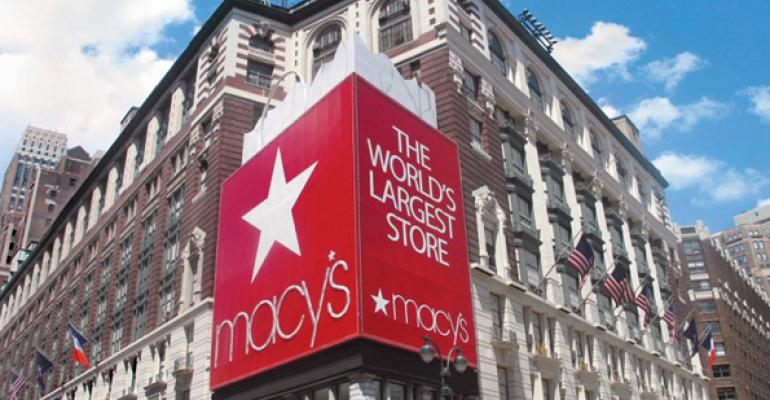Macy’s Inc. has dipped its toe in the off-price business with four pilot stores in metro New York City. The stores, which will operate under the Macy’s Backstage banner, will average about 30,000 sq. ft. They will open this fall.
“We’re all very excited about the potential for this new initiative,” said Macy’s CFO Karen M. Hoguet during the chain’s recent earnings conference call. “We believe that these stores will help us increase our share of wallet with existing Macy’s customers as well as bring new faces into Macy’s stores.”
Macy’s Backstage will offer an assortment of women’s, men’s and children’s apparel, shoes, fashion accessories, housewares, home textiles, intimate apparel and jewelry. Merchandise will include clearance goods from Macy’s stores, as well as special buys from well-recognized fashion brands priced at between 20 percent and 80 percent off regular prices.
Unlike Macy’s traditional stores, Macy’s Backstage will not be driven by promotional events. Macy’s coupons will not be accepted in the off-price locations.
“Backstage is a new retail concept that the Macy’s team has built from scratch over the past six months. It will be an exciting shopping experience supported with compelling marketing, both traditional and mobile,” said Peter Sachse, Macy’s chief innovation and business development officer, in a statement. “As with all of Macy’s innovations, we will test and learn to see what resonates most with customers so we can adjust before rolling out additional locations.”
Saturated segment
Given the strength of the off-price business, it’s not surprising that Macy’s wants a piece of the pie. Off-price sales are growing at more than twice the speed of the overall apparel market, generating about $38 billion annually, according to Customer Growth Partners. Total sales for the five largest off-price retailers in the U.S. increased by 6 percent during 2013, versus a 1 percent gain from national apparel sales overall, according to the NPD Group.
Macy’s, which operates about 885 stores in 45 states, the District of Columbia, Guam and Puerto Rico under the names of Macy’s, Bloomingdale’s, Bloomingdale’s Outlet and Bluemercury, saw revenue decrease in the first quarter to $6.2 billion for the first quarter, down 0.7 percent below last year or 0.1 percent on a comp owned plus licensed basis. According to Macy’s management, the acquisition of Bluemercury helped total sales, but stores closings and lower revenue offset Bluemercury’s impact.
Cincinnati-based Macy’s is very late to the off-price game, according to Paul Swinand, an equity analyst with Morningstar Inc. who covers Macy’s. He says investors have wondered for years why the department store chain hasn’t pursued an off-price strategy.
“With the strength of the off-price segment, it would be crazy to do nothing,” Swinand says. “But it would be crazy to announce plans to open 100 stores without testing it. Testing is the right move.”
Macy’s will be competing head-to-head with Nordstrom’s Rack concept, as well as Saks Fifth Avenue’s Off 5th. Neiman Marcus also has an off-price concept.
In addition to these upscale chains, Macy’s Backstage will compete with off-price behemoths TJX, which operates more than 2,000 stores under the T.J. Maxx, Marshalls and HomeGoods banners and Ross Stores Inc., which operates more than 1,200 Ross Dress for Less stores and plans to double its store count. And then there’s Burlington, which operates about 500 stores under the Burlington Coat Factory, Cohoes Fashions, Super Baby Depot, MJM Designer Shoes and Burlington Shoes brands.
Macy’s also will compete against smaller off-price concepts, especially in the Northeast, where Century21 Department Stores and Forever21 RED have a foothold.
“I know everyone talks about how hot the off-price category is, but I think it’s fairly saturated,” Swinand contends. “I just don’t see a ton of opportunity. For a company the size of Macy’s, it takes a lot to move the needle—more than just a few stores.”
Chains differentiate themselves in the off-price sector by their brand selection. “Because of the sheer volume of product that Macy’s carries, and their longtime relationships with vendors, they will succeed in presenting diverse offerings,” predicts Anjee Solanki, national director of retail services USA for Colliers International.
Track record of success
In the retail sector, Macy’s is known for its innovative omni-channel strategy. Many experts contend that the chain sets the bar for other retailers when it comes to online strategies. That’s why those same experts believe Macy’s will make Backstage a success.
“Macy’s will do quite well with this concept as they’ve been a quiet retail giant that has stayed true to the brand and to who they are,” Solanki says. “They’ve been very strategic in focusing on this roll-out, and perhaps, letting its competitors take the lead in testing out this type of concept so that they can then learn from them.”
Solanki adds that site selection for Macy’s Backstage is critical. “Traditional Macy’s shoppers will have to make the decision to potentially go further out for the new concept,” she says.
The pilot store locations are: Sheepshead Bay in Brooklyn; Queens Place in Elmhurst; Lake Success Shopping Center in New Hyde Park; and Melville Mall in Huntington. Each Macy’s Backstage store is expected to hire a staff of about 30 associates and will include amenities such as free WiFi and spacious fitting rooms. One location will also test a café concept.

